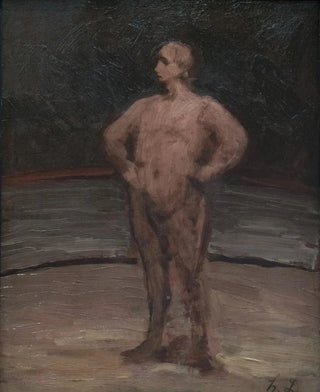Art print | The Wrestler - Honoré Daumier


View from behind

Frame (optional)
Reproduction of The Wrestler - Honoré Daumier – Captivating Introduction
In the vibrant universe of art, certain works emerge with an intensity that transcends time and space. "The Wrestler" by Honoré Daumier is one of those pieces that captivates and intrigues. This striking depiction of a man in the midst of a fight evokes not only physical strength but also the inner and social struggles of the era. Daumier, known for his social and political engagement, manages to capture in this painting the essence of the human condition. The art print of this work allows for an appreciation of the depth of its message while offering a window into the spirit of the 19th century, a period marked by social upheavals and identity questions.
Style and uniqueness of the work
"The Wrestler" stands out for its style that is both realistic and expressive. Daumier, master of caricature and lithography, uses bold strokes and pronounced shadows to bring his subject to life. The wrestler, frozen in a dynamic posture, appears both powerful and vulnerable, embodying the dualities of strength and fragility. The choice of colors, often earthy and dark, emphasizes this tension between raw energy and underlying melancholy. The composition of the piece, centered on the wrestler, immediately draws the eye, while the background, almost indistinct, highlights the isolation of the character facing his challenges. This painting does not merely depict a moment of physical struggle; it also evokes deeper struggles, those that unfold within each individual.
The artist and his influence
Honoré Daumier, born in 1808, is an iconic figure of French art. His work, which oscillates between political caricature and scenes of everyday life, bears witness to a deep commitment to the injustices of his time. Through his works, Daumier was able to denounce societal flaws while celebrating the dignity of the working classes. His influence is felt in the development of realism, an artistic movement that seeks to represent life as it is, without embellishment. Artists who followed, such as Gustave Courbet and Édouard Manet, were inspired by

Matte finish

View from behind

Frame (optional)
Reproduction of The Wrestler - Honoré Daumier – Captivating Introduction
In the vibrant universe of art, certain works emerge with an intensity that transcends time and space. "The Wrestler" by Honoré Daumier is one of those pieces that captivates and intrigues. This striking depiction of a man in the midst of a fight evokes not only physical strength but also the inner and social struggles of the era. Daumier, known for his social and political engagement, manages to capture in this painting the essence of the human condition. The art print of this work allows for an appreciation of the depth of its message while offering a window into the spirit of the 19th century, a period marked by social upheavals and identity questions.
Style and uniqueness of the work
"The Wrestler" stands out for its style that is both realistic and expressive. Daumier, master of caricature and lithography, uses bold strokes and pronounced shadows to bring his subject to life. The wrestler, frozen in a dynamic posture, appears both powerful and vulnerable, embodying the dualities of strength and fragility. The choice of colors, often earthy and dark, emphasizes this tension between raw energy and underlying melancholy. The composition of the piece, centered on the wrestler, immediately draws the eye, while the background, almost indistinct, highlights the isolation of the character facing his challenges. This painting does not merely depict a moment of physical struggle; it also evokes deeper struggles, those that unfold within each individual.
The artist and his influence
Honoré Daumier, born in 1808, is an iconic figure of French art. His work, which oscillates between political caricature and scenes of everyday life, bears witness to a deep commitment to the injustices of his time. Through his works, Daumier was able to denounce societal flaws while celebrating the dignity of the working classes. His influence is felt in the development of realism, an artistic movement that seeks to represent life as it is, without embellishment. Artists who followed, such as Gustave Courbet and Édouard Manet, were inspired by






